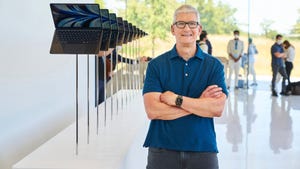Novalux Details Laser Advance
Launches first product and describes technology -- some of it -- for making high-power, surface-emitting lasers
March 19, 2001

ANAHEIM, Calif. -- OFC2001 -- At OFC in Anaheim, California, today, Novalux Inc. launched its first product line of high-power 980-nanometer lasers for pumping erbium doped fiber amplifiers (EDFAs). The lasers come in two flavors: singlemode pumps offering 200 or 360 milliwatts of optical power, or multimode devices offering 750 mW.
Novalux claims that these lasers are the most powerful of their kind, delivering 100 times more power than other surface-emitting lasers or VCSELs (vertical cavity surface-emitting lasers). Until now, it's kept details of this breakthrough very close to its vest. But on Thursday, Dr. Aram Mooradian, Novalux's founder and CTO, will present a post-deadline paper at the conference, describing the technical details of the laser for the first time.
Don't want to wait until Thursday? Malcolm Thompson, Novalux's CEO gave Light Reading a preview of the technology.
The world of lasers is split into two camps: surface emitters and edge emitters. Surface emitters have two big advantages over edge emitters: They throw out a nice circular beam that's easy to couple into a fiber; and they can be tested on-chip, before the wafer is diced and packaged, which leads to big cost savings (see Laser Blazers). But traditionally they've always been low power, on the order of a few milliwatts.
One reason VCSELs are inherently low power is because they are very thin devices with a small volume of active material. Increasing the volume of active material by increasing the diameter of the laser does not boost output power very much because of a problem called "current crowding," says Thompson.
Novalux has overcome this problem, he explains: "Current crowding is a little bit like water in a bath tub. When there's not much water in the bath, the water only falls down the edge of the plug hole. Even if you make the plug hole bigger, you don't get much more water falling down it." In his metaphor, the water is the laser's electrical current, and the plug hole is the laser aperture.To prevent current crowding, Novalux has created the laser equivalent of a bath full of water. "We've replaced the thin VCSEL with a reservoir of current and charge," says Thompson.It's not possible to do away with the thin cavity altogether because it fixes the laser's wavelength. Instead, Novalux has created a "coupled cavity device." A thin cavity a few microns thick is fabricated on top of the substrate, as with a standard VCSEL. There's one key difference -- the mirror nearest the substrate has a much lower reflectivity than usual for this type of device. So a substantial portion of the light passes the mirror, passes through the substrate, and hits a third mirror that is 99.9 percent reflective. This substrate cavity, which is about 300 microns thick, provides the reservoir of current. As a result, when Novalux makes its lasers bigger, it gets a lot of optical power out.
The volume of active material is also increased, but when pressed, Thompson refused to give details. There are also some fine tuning and optimization details that he's not so keen to discuss.
Thompson says the technology is scaleable to reach extremely high powers. "If you want extremely high-power devices you can make the devices large, or you can do something unique -- make an array." He figures that it will be possible to make devices that emit several watts of power this way.
Novalux aims to be booking revenues by Q3 2001. Thompson reckons the market will be quite substantial: "People are quite concerned about the JDSU/SDL merger, and they're looking for new suppliers." Right now JDSU/SDL have a near monopoly on the 980-nanometer pump laser chip market, controlling about 80 per cent of it, he says.
— Pauline Rigby, senior editor, Light Reading http://www.lightreading.com
You May Also Like










